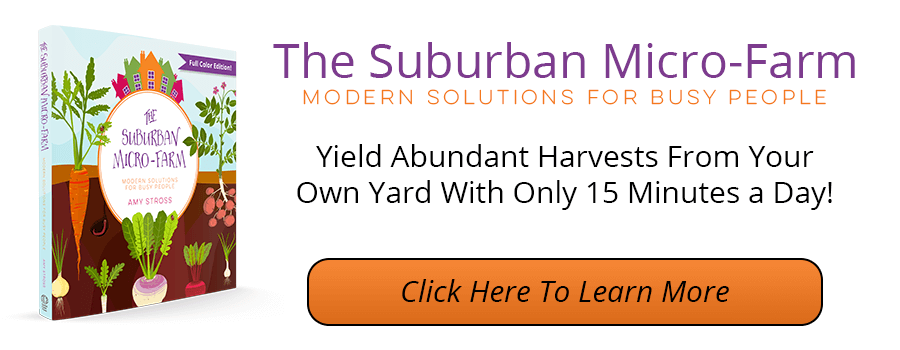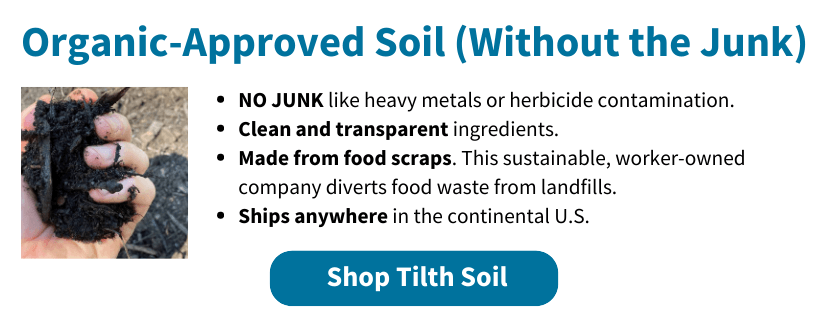How To Start No Till Gardening

Have you heard about the ecological benefits of the no-till garden? Replace your old habits with these essential steps for a successful transition.
This page may contain affiliate links. Please read my disclosure for more info.

When I wanted to create gardens in my 0.10-acre yard years ago, I couldn't find any research to support tilling in my small space. I found research that supported tilling for large-scale agriculture, as well as high-production market farms.
But it didn't seem to make a lot of sense for a tiny, sloping yard with obstacles such as trees and chunks of concrete in the soil (from a previous owner's filled-in pool).
Years later, I'm glad I didn't till the soil. Instead, I had a front row seat to watch the gradual development of a living ecosystem that was created by partnering with the soil.
Transitioning to the No-Till Mindset
Does the no-till garden save time? Many gardeners think that without the task of tilling, they'll surely have less work to do. While true in the long run, a successful transition requires a few other habits to start off right.
These no-till habits require a shift in mindset about land management.
Tilling is used to break up and loosen soil, turn up weeds, and quickly incorporate soil amendments. The thinking is that as long as the soil is loose and free of weeds, something should grow!
However, tilling destroys fungal networks and the sticky exudates of soil organisms that hold soil together.
Tilling also destroys humus, the organic component of soil that is necessary for plant life. This results in the need to add more soil amendments to compensate for what nature would have done for free.
Many people switch to the no-till method because they want to take advantage of the soil-building benefits of soil microorganisms. These beneficial soil organisms do the work to keep soil healthy, loose, and full of organic matter. (See: 7 Ways to Improve Soil Quality)
The following actions will encourage soil microorganisms to take up residence in your garden and multiply.
However, just to set the record straight, it won't be an overnight phenomenon. It may actually take a few years before you start to notice the full benefits.

Permanent pathways are an important feature in no till gardening.
No Till Gardening, Step 1: Fertilize the Soil With Weeds
I've had quite a few people tell me about their struggle of transitioning to a no-till garden. They reported out-of-control weeds, which prompted many of them to ultimately return to tilling because it just didn't seem worth it.
Although alarming, it's important to note that weeds are common in the first year after stopping tilling.
Weeds are simply trying to do the job that nature has set out for them: Fertilize the soil. Now, to be sure, there will always be weeds to some extent, healthy garden or not. But an overabundance of weeds are an indication that soil lacks organic matter and needs nutrition.
See: 5 Weeds You Want in Your Garden
If you can stomach it, let the garden go for a year. Take advantage of nature's ability to give the soil what it needs without much work on your part.
Check on the garden once a week, chopping and dropping the weeds. This is a very important step! Otherwise, the weeds will set seeds everywhere.
The chopped-and-dropped weeds will fertilize the soil as they decompose. Their decaying roots will feed beneficial soil organisms.

Herbs are prolific growers. Here, marjoram, parsley, and fennel grow along the garden path.
Would you like to learn more about improving the biodiversity of your garden, reducing maintenance, and increasing yield?
You'll find loads of information just like this in my award-winning book, The Suburban Micro-Farm .

No Till Gardening, Step 2: Fertilize the Soil With Herbs
After weeding, mulch heavily with chopped herbs of all kinds (check out the article about this at Herbal Academy). Herbs also fertilize soil. Comfrey is a good example, but most culinary or medicinal herbs work well.
See: 7 Comfrey Uses in the Permaculture Garden
If letting the garden go like this makes you uneasy, grow a cover crop instead of weeding and mulching. Here's a resource for choosing non-grass-type cover crops for the no-till garden.
After a year of allowing weeds, cover crops, and/or herbs to fertilize the soil, perform a soil test. This will determine which nutrients, if any, your soil is still lacking.
Soil amendments are digested by soil organisms, who then make those nutrients available to the plants. Therefore, the more soil organisms you attract, the higher the rate of absorption, and the fewer amendments you need to purchase.
That's why adding soil amendments is a step that comes after managing fallow soil.
Industrial agriculture hasn't learned this lesson yet. Synthetic fertilizers are consistently over-applied—even with highly technical calculations and equipment. That's because industrial soils lack the soil life to properly digest what has been applied.
Undigested fertilizer then washes away in the rain, contributing to the dead zone in the Gulf of Mexico and other problematic water quality issues.
All of the above activities will balance things out so that weeds are fewer in years to come.
No Till Gardening, Step 3: Prepare to Plant
When you're ready to plant, use a digging fork to poke holes throughout the garden bed to loosen the soil, improve drainage, and excavate the weeds gently without turning the soil. It is much less work than weeding with hand tools.
Although you want to leave the soil intact as much as possible, the top few inches will be gently disturbed for weeding, planting, and harvesting. This activity allows a bit of aeration without destroying soil organism habitat or beneficial fungal networks.
In time, your no-till-grown plants will better regulate water, enabling them to withstand super wet or dry periods.
No Till Gardening: 5 Ways to Support and Protect Healthy Soil
#1: Practice Crop Rotation
Through tilling, soil diseases and pests are exposed to the air and elements, thereby reducing their viability.
On one hand, the thriving soil ecology in a no till garden can reduce the chance of any one organism (i.e., pest) becoming a problem. However, because the soil is not disturbed regularly, diseases and pests that do show up, can persist.
To combat this, keep good garden notes and rotate crops each year, especially after a pest or disease outbreak.
Your soil will already be healthier with increased numbers of beneficial soil organisms, but this is one more way to set your garden up for success.
#2: Sow Cover Crops
Cover crops protect the soil as a mulch, fertilize the soil with nitrogen and other micronutrients, and attract soil organisms. Because you won't be tilling the cover crop under before planting in the spring, it's important to select cover crops that are killed by winter frost or that are short-lived.
- Try clay-busting plants!
- Buckwheat, daikon radish, and millet are a few examples.
Learn more about cover crops for no till systems from the Rodale Institute. In addition, Anna Hess covers the topic thoroughly in her book,Homegrown Humus: Cover Crops in a No-till Garden.
Cover crops can help improve the health of your soil after years of tilling.

#3: Avoid Walking in the Beds
In a tilled garden, the soil is loosened every year mechanically. To keep soil loose in the no-till garden, however, you need to avoid compaction.
Compaction destroys beneficial soil organisms, their tunnels that allow air and water to infiltrate the soil, and the naturally loose, crumbly texture of healthy soil.
Build permanent garden beds and pathways to avoid having to walk in the beds or de-compact the previous year's pathways.
In permanent beds, simply continue to improve their fertility year after year. This saves time, too!
#4: Add Organic Matter
Add organic matter—lots of it, as often as you can.
- Make your own homemade compost. Learn 6 ways to build a compost bin as well as how to keep herbicides out of your compost (even if you don't use herbicides yourself).
- Homemade worm compost is an essential amendment in my garden. Learn to make your own or purchase organic worm castings.
#5: Mulch, Mulch, Mulch
Mulching shades the soil (habitat for the beneficial soil organisms) and reduces the germination of weed seeds. Mulch between rows of veggies, avoiding contact with the stems of plants. I use grass clippings and leaf mulch because that's what I have the most of.
Wood chips are an excellent topping. Just be sure to keep them on top of the soil as a mulch and away from plant stems. Do not mix them into the soil as an amendment, since this can reduce your garden's vigor.
Rather, allow wood chips to compost naturally on top of the soil. In the winter, try mulching with shredded leaves. (See: Mulching in the Permaculture Garden)

This is leaf mold—leaf mulch that has composted for at least a year. This free organic matter is an essential amendment in my no till garden.
No Till Gardening into the Future
At first, the no-till garden is simply trading one activity (tilling) for another (supporting a soil ecosystem). However, you'll get more joy and satisfaction out of learning how to fertilize, support, and protect your soil.
Respect the role of microorganisms and you'll be on your way to having a successful, abundant garden!
Have you transitioned to a no till garden? What has your experience been like?
READ NEXT:
- How to Improve Clay Soil in 6 Steps
- How to Keep Herbicides out of your Compost Bin
- What is Comfrey and How to Grow It
>>> Get my free 19-page Guide to Organic Soil Amendments for more ideas:
How To Start No Till Gardening
Source: https://www.tenthacrefarm.com/transitioning-to-a-no-till-garden/
Posted by: phillipsnotat1938.blogspot.com

0 Response to "How To Start No Till Gardening"
Post a Comment